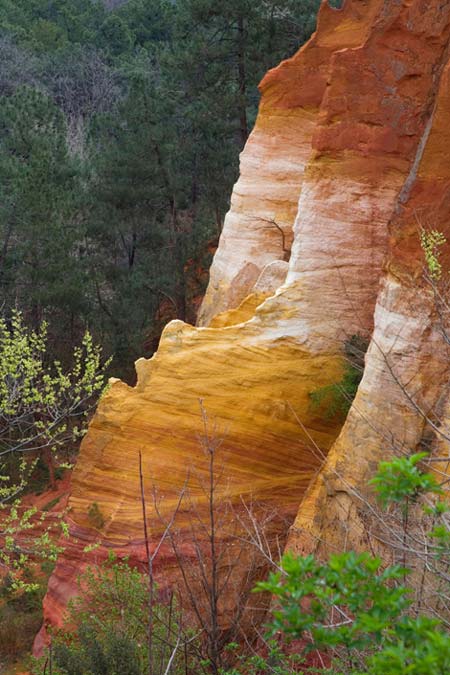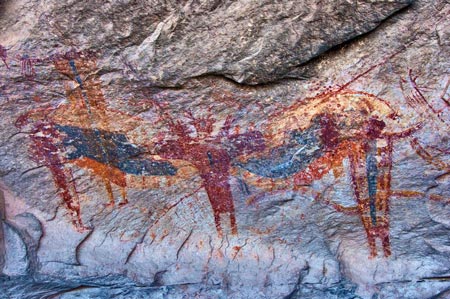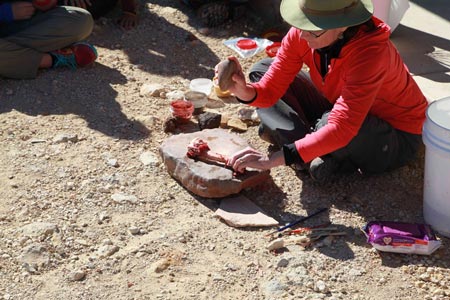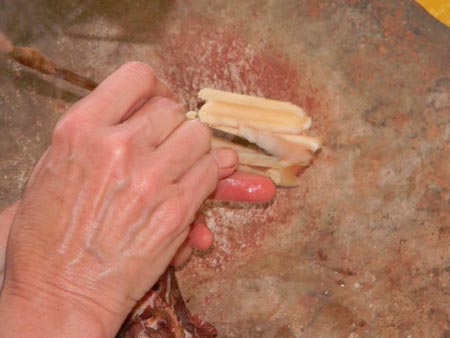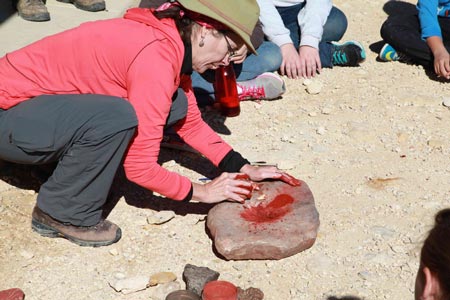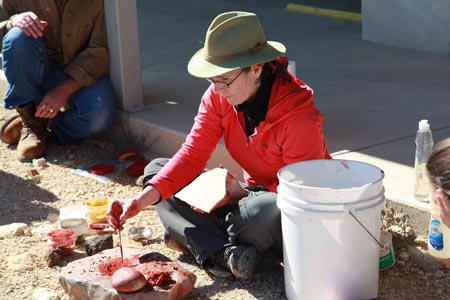What pigments were used for cave painting and where did they come from?
A visit to Lascaux, France would reward you with this (Figure 1), one of the walls of the cave. It dates back to the Palaeolithic period 17,000 years ago.
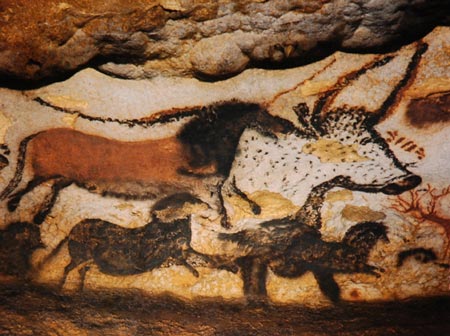
Figure 1: Lascaux cave painting. The LIFE Premium Collection/Getty Images.
It’s bold, clear and exciting, but leaves us with a number of questions.
- What did the Palaeolithic people use to paint their cave art?
- How did they paint the objects on to the wall?
- How have they lasted so long?
The problem is that, in the study of cave art, archaeologists have spent a lot of time trying to interpret the art, but many seem to disregard the paints because the assumption was that they are easy to analyse and understand.
If that were true it still left another question: Where did they get their materials from?
The people had to have used the things around them especially the minerals and rocks.
Recent archaeological work has uncovered some of the tools these people used. One notable find is a shell (in this case an abalone shell) used to hold the pigment and a quartzite stone for grinding up the pigments like charcoal and ochre (Figure 2), and for the paint brush the artist used one of the thin bones from the front leg of a wolf with one end dipped in ochre.
Analysing and studying the various compounds such those above allows us to understand something of the technology employed in cave painting.
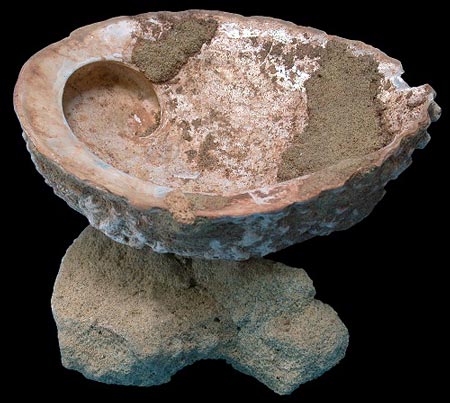
Figure 2: Abalone shell with stone used for grinding pigments. Image courtesy of Science / AAAS.
- Did all the materials come from the local area?
Comparing the minerals used in an area with those found there allows archaeologists to determine the trade routes of these early painters. The aims of analysing paint from any painting are to gain some idea of its composition, its preparation and its geographic origin. Obviously the paints these early peoples used must have been very durable and the results of this art have been found in many parts of the world other than Eurasia.
Palaeolithic artists seem to have used two main colours although others have been found in some cave art. The dominant two are red (which tends to be iron oxide: natural hematite or heated goethite) and black (charcoal or manganese oxides). These colours were natural materials and are known as ‘pigments’.
Pigment is a Middle English word derived from the Latin pigmentum and pingere meaning ‘to paint’.
Evidence of early pigments
What evidence has been found that supports the idea they used minerals?
Do we know how the Palaeolithic people prepared their pigments?
Excavations of Palaeolithic rock sites in Europe and other parts of the world have found evidence of many pigments. Probably the most spectacular are the shards of ochre formed into shapes such as the following example, Figure 3, from South Africa.
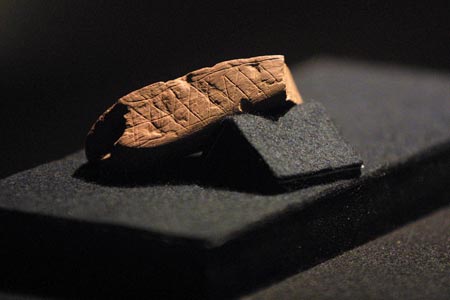
Figure 3: A cross-hatched ochre piece from Blombos Cave, South Africa. Image courtesy of AFP/Getty Images.
The ochre artefacts from the Upper Palaeolithic have often been found in the form of “crayons” (bars with multiple faces and fashioned to a point). These have been found as whole crayons, rubbed and scraped or in fragments, and give the impression that artists used these ochre bars as ‘pencils’.
Ochre is normally found in Lower Palaeolithic sites as a red powder associated with burials. It would be reasonable to consider this red colour is representative of blood and seen as the life spirit of the person. Black ochre has been found in some of these sites but the most common is red.
Ochre has been found on other artefacts as a stain or residue such as on cobble hammers, grindstones and nodules. Arguably these situations, in which ochre is involved, could be interpreted as stages in the process of producing ochre powder or connected to ritual activities.
From analyses of cave painting materials it appears that these pigments have been prepared in different ways. First the pigment is made into a powder by grinding, or it is heated then ground up, then the pigment is mixed with either a binder (the ‘glue’ that binds the pigment to the material) such as plant sap and an extender (a substance added the to paint to increase its volume or bulk).
Where did the pigments come from?
The cave artists must have spent a lot of time wandering around looking for the different colours they needed.
Did someone else do that and trade the pigments with them?
A lot of research has been done in this area and one thing that has been noted is the palette range of this period. In the Lascaux cave in France there are red and yellow hydrated and anhydrous haematite (iron(III) oxide ochres, manganese oxide browns, blacks, and calcite white. In Altamira, Spain, red haematite (iron(III) oxide) is dominant while in Provence, Southern France, alongside the haematite and red earth there is the use of bauxite (red aluminium oxide) and maghemite (a red form of iron(II) oxide). This implies the colour and properties of the pigments were important and not the mineral type.
During the Middle Palaeolithic period, about 40,000 years ago, the process of producing new pigments developed in humans’ skills that were used for many years thereafter; in fact right into the Renaissance period, if not later.
They developed the technique of heating substances to produce a new substance; a chemical reaction in which yellow ochre produces a new red substance different from the natural haematite ochre or red earth (terra rossa). They were not aware they were changing the hydrated iron (III) oxide to anhydrous iron (III) oxide. This does not mean they were chemists but they were aware of chemical change and used it as a craft tool.
The pigments were ground finely. We are not sure how this was done but some millstones have been found with pigment deposits. These grounds were placed into water and the heavier quartz granules sank to the bottom leaving the clay and coloured oxides in suspension. The liquid evaporated either through being left or heated leaving a residue; the ochre pigment. In trade terms, the finer the pigment grain the more expensive it would be. They are illustrated they understood the need for controlling particle size and how a fluid can be used to separate things by density.
In many cases the minerals can be found in the local area, but what’s interesting is that there is evidence of mineral pigments being used which do not appear in the area and so they must have been traded for over large distances. Many of these mineral pigments would be quarried or mined from the rocks near the settlements (Figure 4).
Figure 4: Ochre Quarry of Roussillon, Provence, Southern France. © imageBROKER/Alamy.
Palaeolithic Art and Colour
It is important to consider the colours that were used because it helps us understand the way that artists use their pigments.
- Did these early artists have an understanding of colour and contrast?
Some anthropologists have tried to determine some theory of the use of colour.
- Is there a hierarchy of use of colour?
Berlin and Kay in 1969 argued, based upon analysis of painting from around the world, that first there is a distinction between light and dark, ie white and black. Next, the use of red as a distinctive primary colour, then as secondary colours comes the use of green, yellow, then blue and finally as tertiary colours brown, purple, orange, pink and grey. From this study of modern native artists and their use of colour there does appear to be a theory of colour use.
- Is this paralleled in Palaeolithic art?
The fact Berlin and Kay’s work was carried out on societies found today has made it questionable, but comparing it with those colours seen in Palaeolithic paintings it does give us some basis for considering that there was, developing amongst the artists, some form of colour theory.
Art is not just about the reproduction of an image. Over time it is noted that some artists are fascinated by the effects of light and use this to produce changes in their image. Some use colour symbolically to represent ideas and some use colour to express emotions. So colour theory gives us a vocabulary to begin to understand an art form or design. It is also useful in detecting fakes in painting. It is also clear that with the way the cave painters used colour they were not always accurate in the exact colour of the object.
Writing was not one of the things invented by the Palaeolithic people, so how do we know all this?
Experimental work on early pigments and paints
Here we enter the area of the experimental archaeologist. They are as much scientists as they are historians. One key research project on this subject of cave pigments is Pecos River, USA.
In 1982 the US forensic archaeologist Mike Zolensky analysed and identified the pigments used in 5,000-year-old Pecos Indian rock paintings as natural minerals, ores and soil deposits. But how the pigment was stuck to the rock surface has posed problems.
The range of binders or ‘glue’ available to these ancient tribes was very limited, the most obvious would be saliva or plant extracts such as sap, but the range is large. The following photos show an example of the art of making and using paint with plant sap and animal fat to paint a picture in, what is thought to date, to be the way the Pecos Indians painted the cliff pictures (Figure 5). The process for making the paint is demonstrated in Figure 6.
Figure 5: Pictograph in Fate Bell Shelter in Seminole Canyon State Canyon Park. © Witold Skrypczak / Alamy
|
a) |
b)
|
|
c)
|
d)
|
|
e)
|
f)
|
Figure 6: a) A selection of ingredients: ochre pigments, yucca (for sap), and bone (for marrow); b) extracting the bone marrow; c) mixing the bone marrow with red ochre; d) grinding the paint; e) and f) painting with the paint. Shumla Archaeological Research and Education Center.
If you would like to make your own paints, similar to those used in the Palaeolithic era, then click the links below:
One curious thing is that many of the early cave paintings are often red or black. But as the society grew more sophisticated (more experience developed a knowledge of fashion and culture), the colour palette expanded.
Archaeological researchers have found the principal pigments used by early humans to be:
- Haematite, iron(III) oxide (Fe2O3), gives the mineral ochre a red colour (strangely, if the particle size is large it will also give purple);
- Limonite, the mineral form of hydrated iron(III) oxide-hydroxide of varying composition (FeO(OH)·nH2O), for yellow;
- Limestone, calcite or crushed shells, mineral forms of calcium(II) carbonate (CaCO3), for white;
- Manganite, the mineral form of manganese oxide-hydroxide (MnO(OH)), for brown;
- Pyrolusite, the mineral form of manganese(IV) oxide (MnO2), that gives black;
- Charcoal, the mineral form of carbon (C), which also gives black.
The most notable thing about cave art is that the predominant colours used are black (often from charcoal, soot, or manganese oxide), yellow ochre (often from limonite), red ochre (haematite, or baked limonite), and white (kaolin clay, burnt shells, calcite, powdered gypsum, or powdered calcium carbonate).
Were rocks the only things used by the cave artists to make paints?
From analysis of the things found, it’s clear that in the Palaeolithic period many colours of pigments were obtained from both inorganic sources such as minerals and organic materials like as dyes from such things as plants or animals. These were used to paint various surfaces such as rock, leather, clothing, tools, and indeed the human body.
The palette of the Palaeolithic artist was comprehensive in range, but were there any colours they found difficult?
It is noticeable that blue and green are missing from the palette.
It’s understandable why blue was missing. It’s because of the rarity of easily obtainable blue minerals but green is more difficult since malachite and green earth (terre verte) are found in large quantities and, as pigments, they are very stable. Maybe the light of the cave (or lack of it) or the yellow of a torch or oil lamp affected the way the colour was seen.
Could it be the luminosity or brightness of the green colour was poor and so did not show up very well?
For early civilisations blue was the most difficult colour to obtain in Europe. It was mostly obtained from powdered azurite (a form of copper carbonate) or the mineral lazurite which, because of its rarity, was often polished and worn as beads.
In other parts of the world sources were azurite and certain clays. In America there is evidence of Native Americans getting indigo dye from either Guatemala or Ecuador, which was traded well up into Kansas, long before the Spanish arrived. Unlike the Asian indigo which has green tones, the American indigo has purple tones. However, indigo was not used extensively as paint so the most expensive pigment was to be blue.
Art historians have shown that early humans soon learned that mixing pigments created a richer range of hues.
Other Forms of Cave Art
How similar or different are the cave arts in other parts of the world?
The petroglyphs of the Eastern Dakhleh in Egypt are different to the rock paintings of Europe. They are incisions made into the rock and come from a Neolithic civilisation of the Holocene (around 7,000-6,500 years ago and a pre-pottery age). The civilisation appears to have had artistic trends that can be seen to have influenced the art of the kingdoms of the ancient Egyptians. Yet they still maintain something of the culture of the Palaeolithic art.
These are of such interest that the Dakhleh Oasis Project (DOP), an international, interdisciplinary mission has been studying them since 1977. But Saharan rock art from many sites has been known about since 1923, and was written about by Hans Winkler in 1939.
They are also interesting because the petroglyphs show stylised female figures with giraffes being led by rope, and other scenes. The inclusion of female figures is unique within the Sahara region. They appear as stylized outlines, have a number of interpretations, and are still the subject of research.
The women are seen as being pregnant, or perhaps having a “pear-shaped” (steatopygic) body. What are seen as common traits are a weakly formed upper body, an outlined head, spindly torso and vestigial arms, plus a heavily accented lower body whose large size is covered by a skirt, frequently richly decorated. There are some very refined images, showing tattoos and body paintings, hairstyles, bracelets and necklaces, and artistic ornamental attire.
The women are shown in a number of poses, some dancing and others wearing face masks. There are compositions where animals, chiefly giraffes, are being led towards the women (Figure 7). What seems consistent is the striking disproportion in size between the animals, those leading them, and the female figures. The female figures are much larger leading to the hypothesis that these are images of female gods or deities.
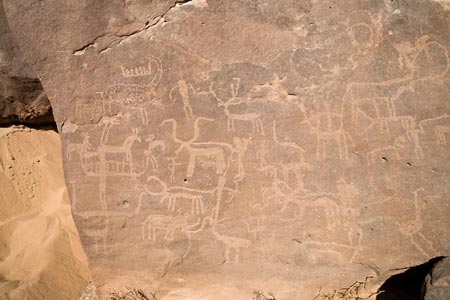
Figure 7: A parade of animals heading towards the left hand side of the picture and towards female figures. © Mike P Shepherd / Alamy.
This discussion of some of the early art forms from different parts of the world illustrates the importance of the link between art, the development of the modern human consciousness, and religion within a civilisation.
Downloads
Cave pigments
PDF, Size 0.56 mb












